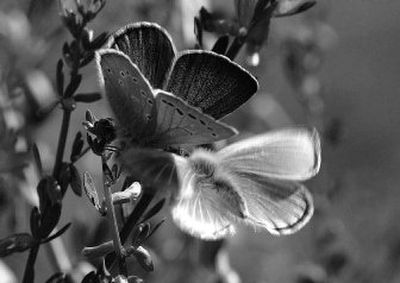Wind beneath their wings

LOS ANGELES – The heat lamps have been blazing for half an hour in Jana Johnson’s laboratory, orange light flooding over a sea of plastic cups. Johnson hovers, waiting for metamorphosis. She points at a brown pod in one of the cups.
“Look at the seams. This one is ready to pop,” she says.
The seam widens. A sliver of gray wing appears.
“Go. Go. Go,” she cajoles. “You can do it. Go.”
In a double-wide trailer in Los Angeles’ San Pedro area, Johnson is presiding over the rebirth of the Palos Verdes blue, one of the rarest butterflies in America. As manager of a pioneering program to breed the butterfly in captivity, she has witnessed hundreds of moments like this one: butterfly after butterfly crawling out of its pod, or pupa casing, lured by the spring warmth and light.
Johnson, 37, a Texas-born biologist, never tires of the drama. Each “pop” means that the Palos Verdes blue is one butterfly further from extinction.
Slightly more than 200 Palos Verdes blues remain in the wild, virtually all of them on this 330-acre military fuel depot uphill from the Port of Los Angeles on the Palos Verdes Peninsula.
This is proving a bountiful year for boosting the numbers of the thumbnail-sized creature with cobalt blue wings and a hankering for Gatorade.
Pupae are popping in greater numbers than ever. Johnson has been tending to a bumper crop of 720, half in San Pedro and half at a new site at Moorpark College in Ventura County.
Now she is ringmaster of a four-ring circus – new butterflies, the eggs they lay, larvae and more pupae.
She is lucky to catch four hours of sleep before she zigzags from her home in the San Fernando Valley, 40 miles southeast to San Pedro or 23 miles northwest to Moorpark, fueled by coffee and the music of Garth Brooks and the Dixie Chicks.
If the Palos Verdes blue is to rebound, scientists say, the program must produce enough pupae to establish colonies elsewhere on the peninsula.
Spring is prime time for butterfly “hatching,” and Johnson arrives at her lab before the heat lamps click on at 7 a.m. She knows the first pupae will start popping at 7:30 a.m. with military precision.
She tries to coax butterflies out of their pods by talking to them in the same soothing tone she uses with her two sons, ages 7 and 4. If a butterfly struggles, unable to spring free of its pod, she ratchets up the energy like a mother at a sports match.
“Shake it off,” she urges a newly emerged male with a tiny piece of casing still hanging from its wing. “This is the part that makes me so freaking nervous.”
If the bug doesn’t escape the casing, its wing won’t expand properly.
“If that doesn’t expand, he can’t fly, and if he can’t fly, he can’t mate,” she said. “And if you’re not pretty, you get rejected.” In this race to save the Palos Verdes blue, everything is about courtship, mating and eggs.
The male she is watching emerges successfully; blue glinting on his folded wings. Johnson exhales in relief.
She plays her wards music, starting with Brooks’ “Do What You Gotta Do,” and “Defying Gravity” from the stage musical “Wicked.” She finishes with the blues, of course: “Better Not Look Down,” by B.B. King.
At feeding time, she kneels by the wood-and-netting boxes where the butterflies live, offering each a wad of honey-water-soaked toilet paper until its proboscis, or feeding tube, shoots out like a long straw.
Some won’t eat unless she keeps holding the wad. “Princess feeders,” she calls them.
The butterflies are normally fed the honey-water mix, a substitute for the locoweed and deer weed nectar they drink in the wild. But Johnson has started using Fierce Melon Gatorade, based on research at the University of Florida, which is doing captive breeding with the endangered Miami blue butterfly.
Johnson’s work with the Palos Verdes blue began four years ago, shortly before she went through a divorce.
“Rescuing butterflies kind of rescued me,” she said.